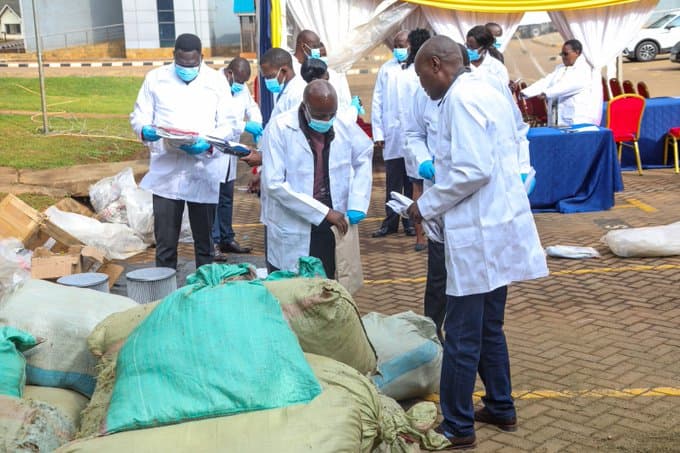We're loading the full news article for you. This includes the article content, images, author information, and related articles.
A record-breaking maritime seizure of over one tonne of methamphetamine off Kenya's coast has exposed the nation's critical role as a transit hub in the global narcotics trade, prompting a high-level government response.

MOMBASA, KENYA – The Kenyan government has announced its intention to publicly destroy a massive Sh8.2 billion consignment of methamphetamine seized in the Indian Ocean, a move Interior Cabinet Secretary Kipchumba Murkomen stated will send a clear message of the state's intolerance for drug trafficking. The seizure, one of the largest in Kenya's history, has cast a harsh spotlight on the nation's vulnerability as a major transit point for narcotics flowing from Asia to markets in Africa and Europe.
The operation, codenamed "Bahari Safi 2025.01," took place on Saturday, October 25, 2025, when a multi-agency security team intercepted a stateless dhow named "Igor" approximately 630 kilometers east of Mombasa. Onboard, they discovered 1,024 kilograms of high-purity methamphetamine concealed in 769 packages, some disguised as roasted coffee. Six Iranian nationals who were crewing the vessel were arrested and are currently in custody pending arraignment.
Speaking on Sunday, October 26, 2025, during a church service in Kisumu, CS Murkomen confirmed the details of the seizure and the government's subsequent plans. "The suspects will be taken to court, and very soon you will see us destroying those illicit substances because we have resolved as a nation to fight all kinds of vices destroying our people," he announced. Initial tests have reportedly confirmed the substance is methamphetamine with 98 percent purity.
The successful interception was the result of extensive collaboration between Kenyan and international security agencies. The Kenya Navy, leading the operation, worked in concert with the Directorate of Criminal Investigations (DCI), the Kenya Coast Guard Service, and the National Intelligence Service. Crucial support was provided by regional and international partners, including the Regional Coordination of Operations Centre (RCOC) in Seychelles and the Regional Maritime Information Fusion Centre (RMIFC) in Madagascar. A maritime patrol aircraft from the Seychelles Coast Guard provided aerial surveillance that was vital in tracking the vessel.
Deputy Commander of the Kenya Navy, Brigadier Sankale Kiswaa, noted that the vessel had been on the radar of international drug enforcement agencies for some time before its capture. The operation underscores a heightened level of maritime surveillance and intelligence sharing aimed at curbing the rampant use of the East African coastline as a drug trafficking corridor.
This record seizure is a stark reminder of Kenya's long-standing role as a significant transit country for illicit drugs, particularly heroin from Southwest Asia and, increasingly, methamphetamine. Trafficking organizations exploit the country's extensive coastline and corrupt elements within government and security apparatus to move narcotics. The United Nations Office on Drugs and Crime (UNODC) has previously highlighted the 'southern route' which sees drugs from Afghanistan trafficked via the Makran coast of Iran and Pakistan to East Africa for onward distribution.
The Sh8.2 billion haul is the second-largest narcotics bust in Kenyan history by weight, following the 1.1 tonnes of cocaine seized in Nairobi and Malindi in 2006. In 2014, authorities intercepted a vessel, the MV Al Noor, carrying 370.8 kilograms of heroin, which was subsequently destroyed at sea on presidential orders to signal a tough stance against trafficking. Despite these high-profile successes, experts believe the quantities seized represent only a fraction of the total volume passing through the region.
The influx of hard drugs through the region has devastating consequences, fueling a rise in local addiction, crime, and public health crises, including the spread of HIV. CS Murkomen has previously linked the rise in serious crime across Kenya directly to rampant drug and substance abuse. Furthermore, the proceeds from drug trafficking are known to finance other forms of transnational organized crime, including terrorism, and contribute to high-level corruption that undermines state institutions.
The government's pledge to destroy the seized methamphetamine publicly is a symbolic act intended to demonstrate a renewed commitment to tackling this menace. CS Murkomen stated that Kenya will enhance its partnerships with regional and global allies to dismantle the criminal networks behind the trade. However, challenges remain, including outdated laws and the need for greater resources and capacity within anti-narcotics units to effectively investigate and prosecute powerful drug barons, not just low-level couriers. The successful prosecution of the six Iranian suspects and the subsequent disruption of their network will be a critical test of the state's resolve.
Keep the conversation in one place—threads here stay linked to the story and in the forums.
Other hot threads
E-sports and Gaming Community in Kenya
Active 6 months ago
Popular Recreational Activities Across Counties
Active 6 months ago
The Role of Technology in Modern Agriculture (AgriTech)
Active 6 months ago
Investing in Youth Sports Development Programs
Active 6 months ago